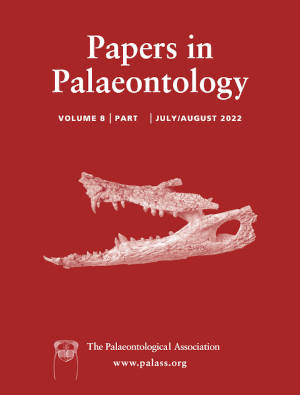Article: Taxonomy and diversity of slit-band gastropods (Order Pleurotomariida) and some slit bearing Caenogastropoda from the Pennsylvanian of the USA
Publication: Papers in Palaeontology
Volume:
8
Part:
2
Publication Date:
2022
Article number:
e1417
Author(s):
Baran Karapunar, Alexander Nützel, Barbara Seuss, and Royal H. Mapes
DOI:
10.1002/spp2.1417
Abstract
Abstract Pleurotomariida have the longest fossil record among living gastropods and are diverse and abundant in the middle and upper Palaeozoic. Its traditional classification is based on adult shell characters. The early shell morphology has been largely unknown. We describe exceptionally well-preserved Pleurotomariida from the Pennsylvanian marine shales of Texas, Oklahoma, Kansas and Ohio. In total, 38 species representing 19 genera are described, including 10 new species, one new genus and one new subgenus: Eirlysella buckhornensis gen. et sp. nov., Shansiella (Oklahomaella) globilineata subgen. et sp. nov., Phymatopleura girtyi, Phymatopleura conica, Worthenia (Yochelsonospira) kuesi, Dictyotomaria turrisbabel, Paragoniozona yanceyi, Spiroscala shwedagoniformis, Peruvispira oklahomaensis, Baylea tenera. Replacement names are Paragoniozona ornata nom. nov. (for Pleurotomaria aspera Girty), Spiroscala quasipulchra nom. nov. (for Euconospira pulchra Batten). The early ontogenetic shells including protoconchs and early teleoconchs are reported in detail for the first time for most taxa. Most species have a protoconch of one whorl as that of living Vetigastropoda. Planktotrophic protoconchs (multi-whorled larval shells with sinusigera) are reported for Platyzona and Peruvispira; they are therefore placed in the family Goniasmatidae (Caenogastropoda). Repaired shell scars were found in juvenile Pleurotomariida specimens (c. 1 mm), suggesting exposure to predation from an early stage of ontogeny. Pleurotomariida are strongly dominant in surface samples of the Finis Shale (Texas) but in bulk samples using fine mesh-sizes, dominance is much less pronounced, indicating a change in clade proportion depending on sampling method. The taxonomic richness and abundance of Pleurotomariida seen in these Carboniferous shales have not been reported from post-Triassic formations.
